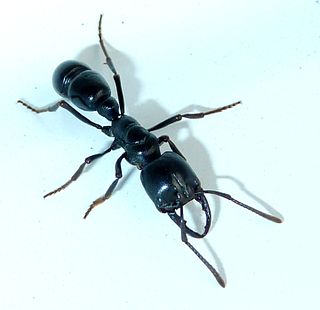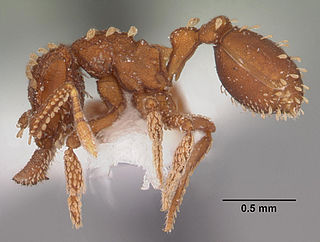
Torus mandibularis is a bony growth in the mandible along the surface nearest to the tongue. Mandibular tori are usually present near the premolars and above the location of the mylohyoid muscle's attachment to the mandible. In 90% of cases, there is a torus on both the left and right sides.

Prostomidae is a family of beetles with no vernacular common name, though recent authors have coined the name jugular-horned beetles. They are often found in dead wood. The family consist of two genera with about 20 species. Prostomis mandibularis is known from North America. Other species of Prostomis are found in Africa, the Pacific region and East Asia. Species of Dryocora are known from New Zealand, Australia and Tasmania.

Lake Miragoâne is a lake in Haiti, located one kilometer southeast of the city of Miragoâne. It is one of the largest natural freshwater lakes in the Caribbean. The lake is 12 km (7.5 mi) long and 25 km² (9.7 mi²) in area.
The flatjaw minnow is a species of cyprinid fish endemic to Mexico. It is considered critically endangered.
Haplochromis mandibularis is a species of cichlid endemic to Lake Victoria. This species can reach a length of 17.4 centimetres (6.9 in) SL.

Macrochelidae is a family of mites in the order Mesostigmata, containing the following genera and species:
Geholaspis is a genus of mites in the family Macrochelidae. There are about 18 described species in Geholaspis.
Geholaspis aeneus is a species of mite in the family Macrochelidae.
Geholaspis asper is a species of mite in the family Macrochelidae.
Geholaspis berlesei is a species of mite in the family Macrochelidae.
Geholaspis comelicensis is a species of mite in the family Macrochelidae.
Geholaspis ilvana is a species of mite in the family Macrochelidae.
Geholaspis lagrecai is a species of mite in the family Macrochelidae.
Geholaspis pauperior is a species of mite in the family Macrochelidae.

Ecsenius mandibularis, also known as the many-toothed blenny, Queensland combtooth blenny or Queensland blenny in Australia, is a species of combtooth blenny in the genus Ecsenius. It is found in coral reefs in the western Pacific ocean, including the southern edge of the Great Barrier Reef. It can reach a maximum length of 7.5 centimetres. Blennies in this species feed primarily off of plants, including benthic algae and weeds.

Plectroctena is an Afrotropical genus of ants, with most species occurring in the rainforest zones of West and Central Africa. Some species are cryptic or subterranean foragers, while others forage in open grassland terrain. The workers forage singly or in groups of 2 to 3. They nest in the earth at varying depths, or in collapsed logs. They prey mainly on millipedes, including their young or eggs.

Hexarthrius mandibularis is the world's largest fork-horned stag beetle. It belongs to the tribe Lucanini, in the family Lucanidae.

Plectroctena mandibularis is a large species of ant that ranges from the Eastern Cape, South Africa, through East Africa to Ethiopia. Their workers forage singly in open terrain, and their colony size seldom exceeds 50 individuals. It is one of the large Plectroctena species, including P. conjugata and P. minor, that specialize on adult millipedes as prey. The nest is composed of chambers that are typically located 2 feet or more below the surface, and the nest entrances are usually marked by large piles of earth.

Talaridris is a genus of ant in the subfamily Myrmicinae containing the single species Talaridris mandibularis.

Myrmecia mandibularis is an Australian species of Myrmecia. Average sizes for the Myrmecia mandibularis is around 15-30 millimetres. They have a similar appearance to the Myrmecia pilosula, except their mandibles are completely black while most of their abdomen is in an orange colour.









